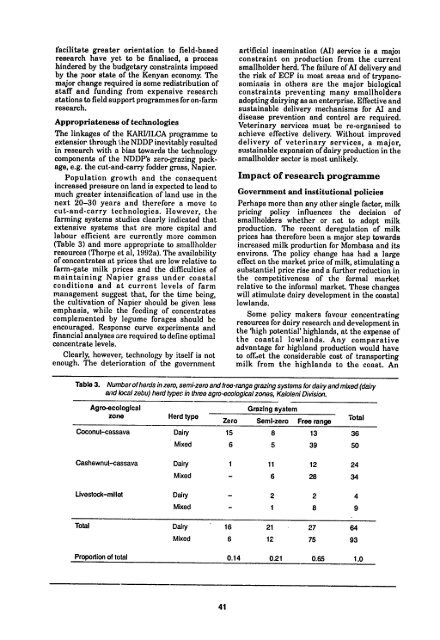aistand south~ern afrkca - (PDF, 101 mb) - USAID
aistand south~ern afrkca - (PDF, 101 mb) - USAID
aistand south~ern afrkca - (PDF, 101 mb) - USAID
Create successful ePaper yourself
Turn your PDF publications into a flip-book with our unique Google optimized e-Paper software.
facilitate greater orientation to field-based<br />
research have yet to be finalised, a process<br />
hindered by the budgetary constraints imposed<br />
by the poor state of the Kenyan economy. The<br />
major change required is some redistribution of<br />
staff and funding from expensive research<br />
stations to field support programmes for on-farm<br />
research,<br />
Appropriateness of technologies<br />
The linkages of the KARIILCA programme to<br />
extensior through t.he NDDP inevitably resulted<br />
in research with a bias towards the technology<br />
components of the NDDP's zero-grazing package,<br />
e.g. the cut-and-carry fodder grass, Napier.<br />
Population growth and the consequent<br />
increased pressure on land is expected to lead to<br />
much greater intensification of land use in the<br />
next 20-30 years and therefore a move to<br />
cut-and-carry technologies. However, the<br />
farming systems studies clearly indicated that<br />
extensive systems that are more capital and<br />
labour efficient are currently more common<br />
(Table 3) and more appropriate to smallholder<br />
resources (Thorpe et al, 1992a). The availability<br />
of concentrates at prices that are low relative to<br />
farm-gate milk prices and the difficulties of<br />
maintaining Napier grass under coastal<br />
conditions and at current levels of farm<br />
management suggest that, for the time being,<br />
the cultivation of Napier should be given less<br />
emphasis, while the feeding of concentrates<br />
complemented by legume forages should be<br />
encouraged. Response curve experiments and<br />
financial analyses are required to define optimal<br />
concentrate levels,<br />
Clearly, however, technology by itself is not<br />
enough. The deterioration of the government<br />
artificial insemination (Al) service is a majoi<br />
constraint on production from the current<br />
smallholder herd. The failure of AI delivery and<br />
the risk of ECF in most areas and of trypanosomiasis<br />
in others are the major biological<br />
constraints preventing many smallholders<br />
adopting dairying as an enterprise. Effective and<br />
sustainable delivery mechanisms for AI and<br />
disease prevention and control are required.<br />
Veterinary services must be re-organised to<br />
achieve effective delivery. Without improved<br />
delivery of veterinary services, a major,<br />
sustainable expansion ofdairy production in the<br />
smallholder sector is most unlikely.<br />
Impact of research programme<br />
Government and institutional policies<br />
Perhaps more than any other single factor, milk<br />
pricing policy influences the decision of<br />
smallholders whether or not to adopt milk<br />
production. The recent deregulation of milk<br />
prices has therefore been a major step towards<br />
increased milk produrtion for Mo<strong>mb</strong>asa and its<br />
environs. The policy change has had a large<br />
effect on the market price of milk, stimulating a<br />
substantial price rise and a further reduction in<br />
the competitiveness of the formal market<br />
relative to the informal market. These changes<br />
will stimulate dairy development in the coastal<br />
lowlands.<br />
Some policy makers favour concentrating<br />
resources for dairy research and development in<br />
the 'high potential' highlands, at the expense of<br />
the coastal lowlands. Any comparative<br />
advantage for highland production would have<br />
to offoet the considerable cost of transporting<br />
milk from the highlands to the coast. An<br />
Table 3. Nu<strong>mb</strong>er ofherds in zero, semi-zero and free-range grazing systems for dairy and mixed (dairy<br />
ad 1ocal zebu) herd type! in three agro-ecological zones, Kalo/eni Division.<br />
Agro-ecological<br />
zone Herd type Zero<br />
Grazing system<br />
Semi-zero Free range Total<br />
Coconut-cassava Dairy 15 8 13 36<br />
Mixed 6 5 39 50<br />
Cashownut-cassava Dairy 1 11 12 24<br />
Mixed - 6 28 34<br />
Livostock-millet Dairy 2 2 4<br />
Mixed - 1 8 9<br />
Total Dairy 16 21 27 64<br />
Mixed 6 12 75 93<br />
Proportion of total 0.14 0.21 0.65 1.0<br />
41

















